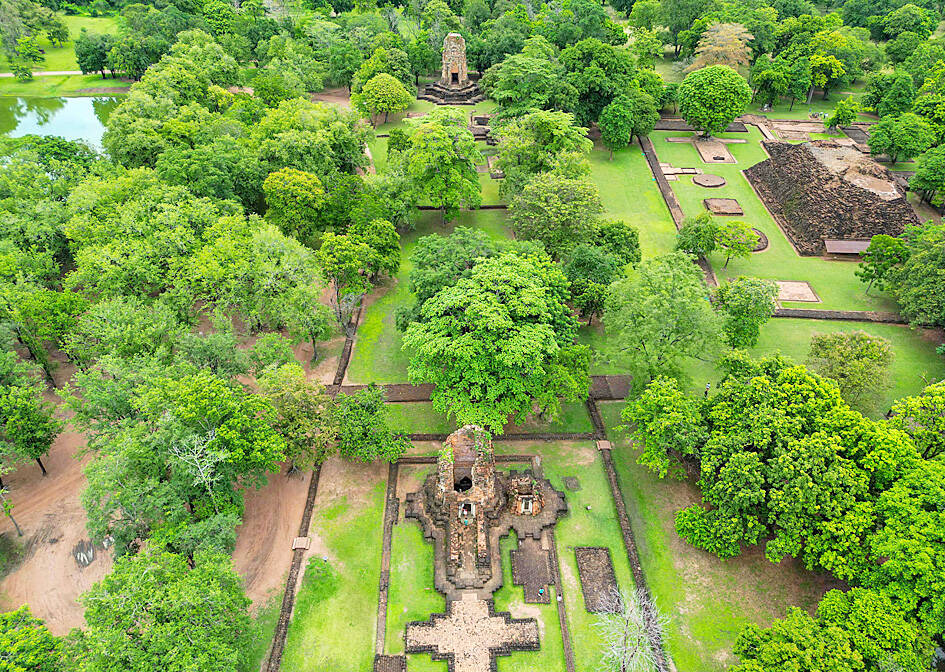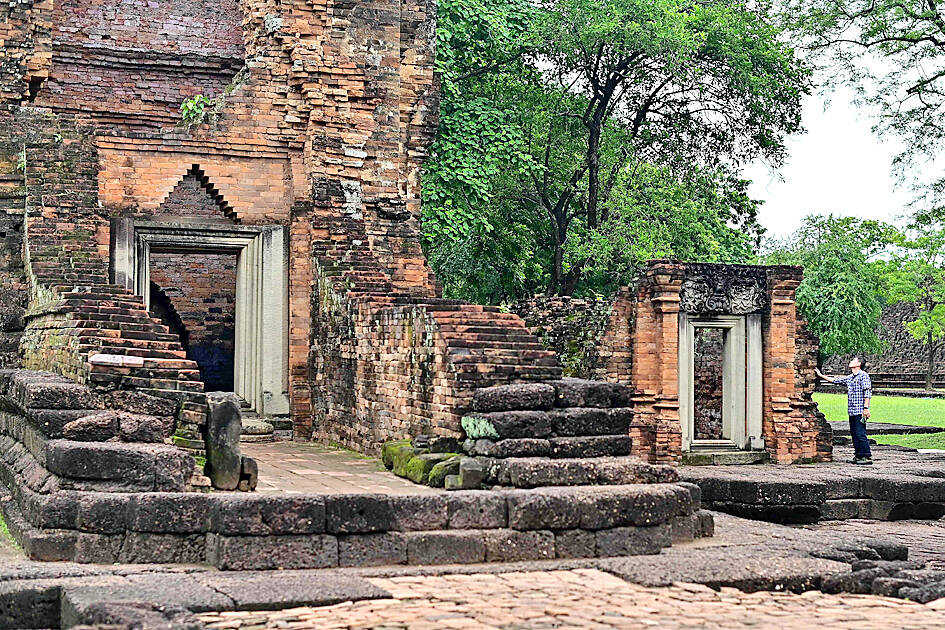Under the scorching sun, Thai archeologist Tanachaya Tiandee clambers through ruined pagodas in the ancient town of Si Thep, trying to unlock their mysteries — a task made harder because parts of the puzzle are missing thanks to decades of looting.
Thailand has a rich collection of historical sites, but foreign looting has stripped many of them, leaving the country scrambling to repatriate its stolen cultural wealth.
“The big picture like the building was discovered, but the artifacts which tell little details are missing, making a lot of stories untold about Si Thep,” Tanachaya said.

Photo: AFP
“It’s like a piece of puzzle was missing,” she said.
The 400-hectare complex, which archeologists date back to between 1,500 and 1,700 years ago, might be inscribed in UNESCO’s cultural world heritage list this week — Thailand’s first addition since 1992.
As 33-year-old Tanachaya carefully excavates the ancient stone constructions, she faces a difficult task piecing together the stories of Si Thep, which lies about 200km north of Bangkok.

Photo: AFP
It is believed that over the years, at least 20 objects have been stolen from the site, with experts identifying 11 in museums in the US.
The real number of looted objects is suspected to be far higher, thanks to a lack of documentation.
Now Tanachaya — who decided when she was young that she wanted to become a Thai version of movie character Indiana Jones — and her colleagues face their own quest. Can they bring their culture’s treasures home?
The Thai government, led at the time by the military, established the Committee to Monitor Thai Antiquities Abroad in 2017.
About 340 objects have been voluntarily repatriated to Thailand since then, according to the latest report by the committee.
However, the process is slow, partly because government officials are wary of jeopardizing diplomatic relations with important allies like the US.
Instead, Thai authorities have pursued a “discreet” diplomatic route, Thailand’s Department of Fine Arts Director-General Phnombootra Chandrachoti said.
“We won’t accelerate anything,” he said.
The Norton Simon Museum in California holds nine Thai artifacts, according to a recent statement from the committee — including one item an independent expert says is from Si Thep park. The items were among 32 scattered in museums across the US, the committee said.
The Norton Simon is only one of a number of US institutions — including New York’s Metropolitan and San Francisco’s Asian Art Museum — that have been named in the growing scandal around art that investigators claim was illegally removed from its country of origin.
The museum told Agence France-Presse it had not heard from the Thai government, but would cooperate with authorities if contacted, and defended holding the items.
The works, which it claimed were legally purchased, “have been carefully preserved and displayed,” said Leslie Denk, vice president of external affairs at the institution.
Thai historians face another dilemma: Si Thep’s bid to become a UNESCO site could boost the local economy — but it could also put the fragile ancient site under strain.
Presently, only 1 percent of visitors to Phetchabun — the province that is home to Si Thep — are foreigners, according to official 2019 data.
The Thai government hopes a UNESCO designation would help boost the kingdom’s tourism sector, which accounts for almost 20 percent of the country’s GDP. However, there are concerns about conservation.
The site is already “almost reaching its fullest capacity” of about 2,000 tourists a day, said Si Thep Historical Park head Sittichai Pooddee.
“We will try to balance things. We will try to not over-promote,” he said.
Missing items mean gaps in the record, which makes it harder to satisfy the curiosity of tourists visiting the site, Thai historian Tanongsak Hanwong said.
“Artifacts dignify Thailand’s past civilization, and when some of the parts are missing, we get stuck and we can’t tell important pieces of the story to the world,” he said.
At Si Thep’s peaceful complex, domestic visitors gaze at a carefully carved pagoda wall.
“It’s the heritage that belongs to Thai people, and that we are proud of. It would be a pity not to get it back,” said Chaowarat Munprom, a 66-year-old retiree.
“It once belonged here,” he said.

Kehinde Sanni spends his days smoothing out dents and repainting scratched bumpers in a modest autobody shop in Lagos. He has never left Nigeria, yet he speaks glowingly of Burkina Faso military leader Ibrahim Traore. “Nigeria needs someone like Ibrahim Traore of Burkina Faso. He is doing well for his country,” Sanni said. His admiration is shaped by a steady stream of viral videos, memes and social media posts — many misleading or outright false — portraying Traore as a fearless reformer who defied Western powers and reclaimed his country’s dignity. The Burkinabe strongman swept into power following a coup in September 2022

‘FRAGMENTING’: British politics have for a long time been dominated by the Labor Party and the Tories, but polls suggest that Reform now poses a significant challenge Hard-right upstarts Reform UK snatched a parliamentary seat from British Prime Minister Keir Starmer’s Labor Party yesterday in local elections that dealt a blow to the UK’s two establishment parties. Reform, led by anti-immigrant firebrand Nigel Farage, won the by-election in Runcorn and Helsby in northwest England by just six votes, as it picked up gains in other localities, including one mayoralty. The group’s strong showing continues momentum it built up at last year’s general election and appears to confirm a trend that the UK is entering an era of multi-party politics. “For the movement, for the party it’s a very, very big

ENTERTAINMENT: Rio officials have a history of organizing massive concerts on Copacabana Beach, with Madonna’s show drawing about 1.6 million fans last year Lady Gaga on Saturday night gave a free concert in front of 2 million fans who poured onto Copacabana Beach in Rio de Janeiro for the biggest show of her career. “Tonight, we’re making history... Thank you for making history with me,” Lady Gaga told a screaming crowd. The Mother Monster, as she is known, started the show at about 10:10pm local time with her 2011 song Bloody Mary. Cries of joy rose from the tightly packed fans who sang and danced shoulder-to-shoulder on the vast stretch of sand. Concert organizers said 2.1 million people attended the show. Lady Gaga

SUPPORT: The Australian prime minister promised to back Kyiv against Russia’s invasion, saying: ‘That’s my government’s position. It was yesterday. It still is’ Left-leaning Australian Prime Minister Anthony Albanese yesterday basked in his landslide election win, promising a “disciplined, orderly” government to confront cost-of-living pain and tariff turmoil. People clapped as the 62-year-old and his fiancee, Jodie Haydon, who visited his old inner Sydney haunt, Cafe Italia, surrounded by a crowd of jostling photographers and journalists. Albanese’s Labor Party is on course to win at least 83 seats in the 150-member parliament, partial results showed. Opposition leader Peter Dutton’s conservative Liberal-National coalition had just 38 seats, and other parties 12. Another 17 seats were still in doubt. “We will be a disciplined, orderly